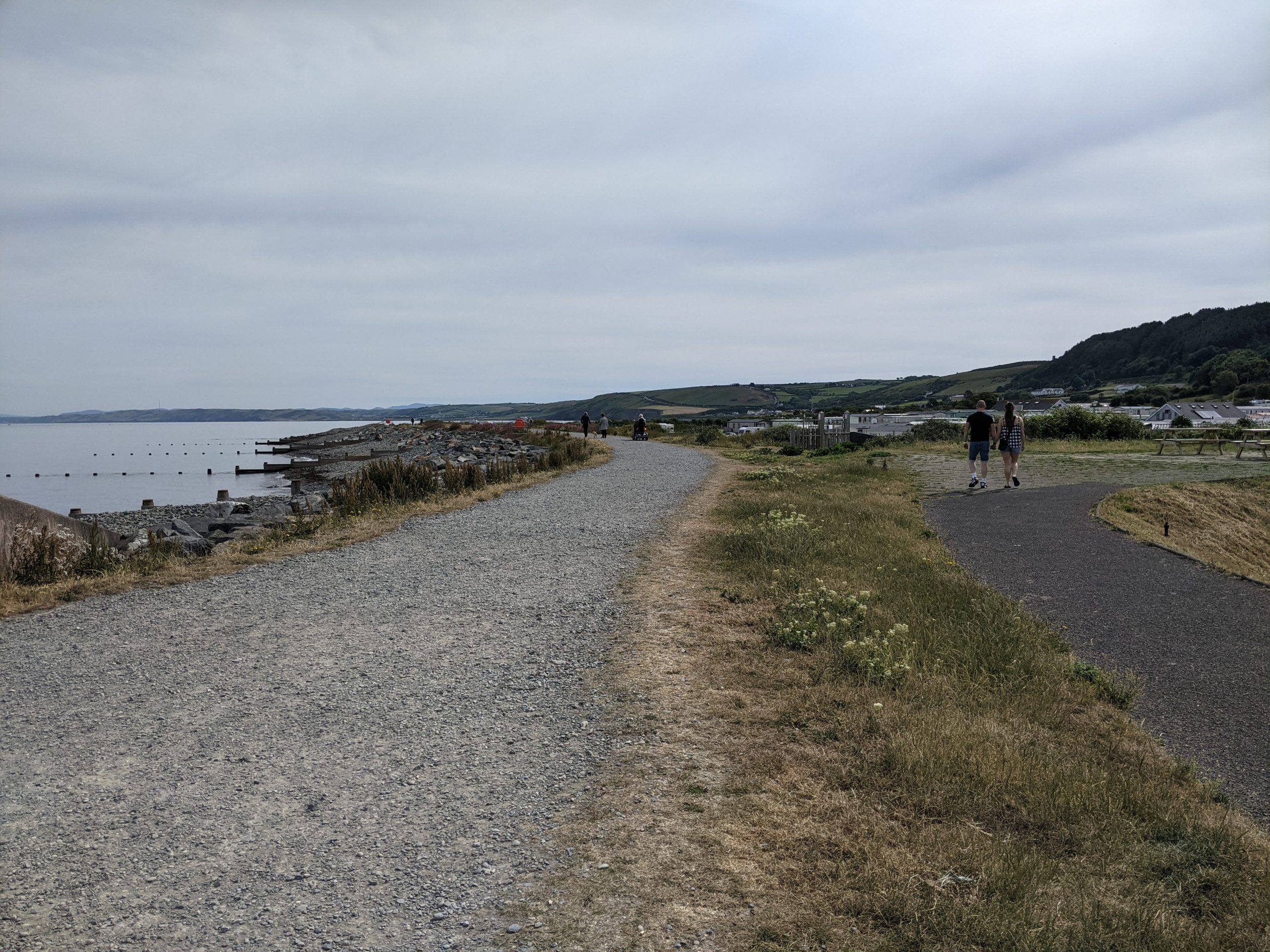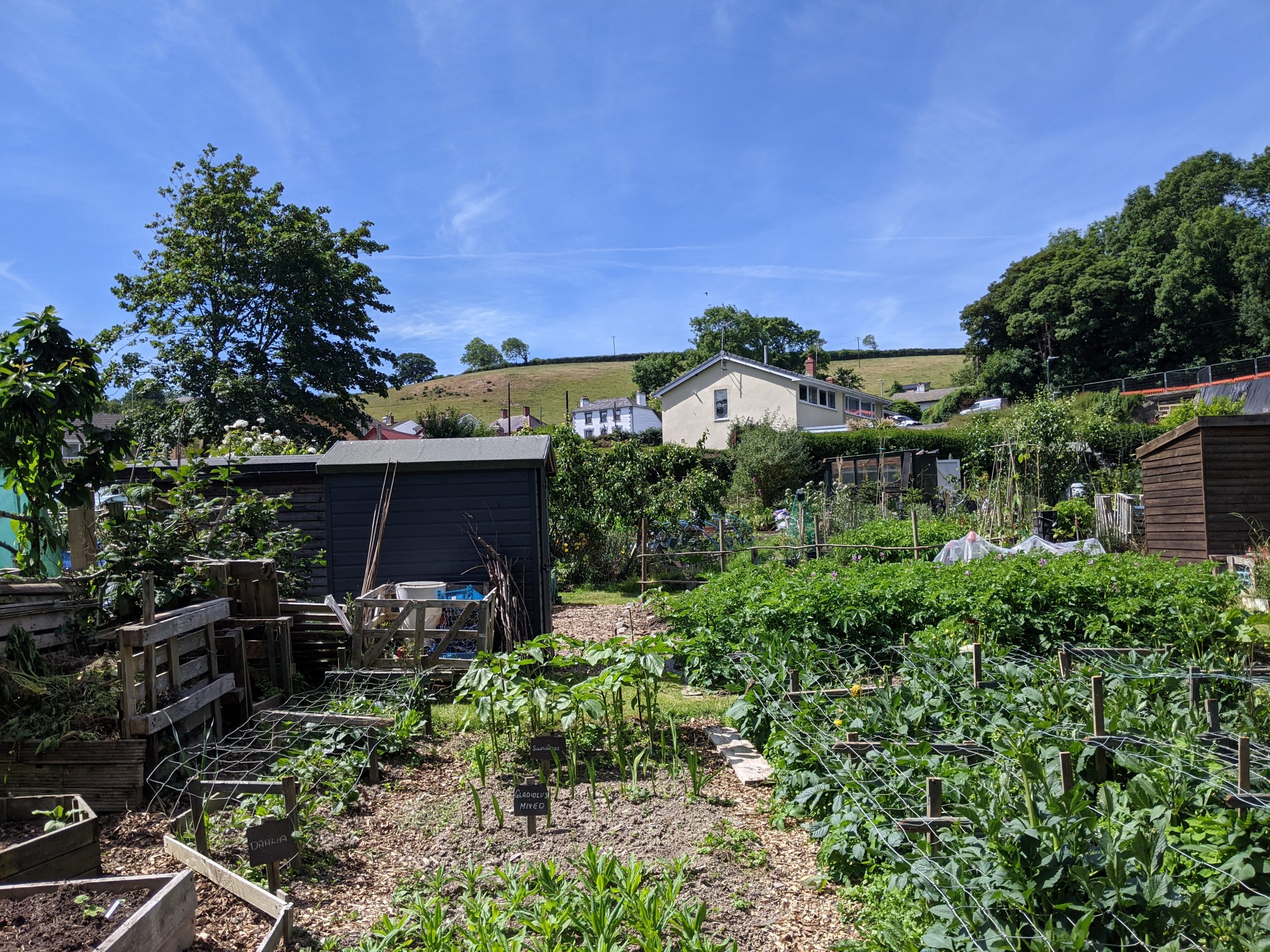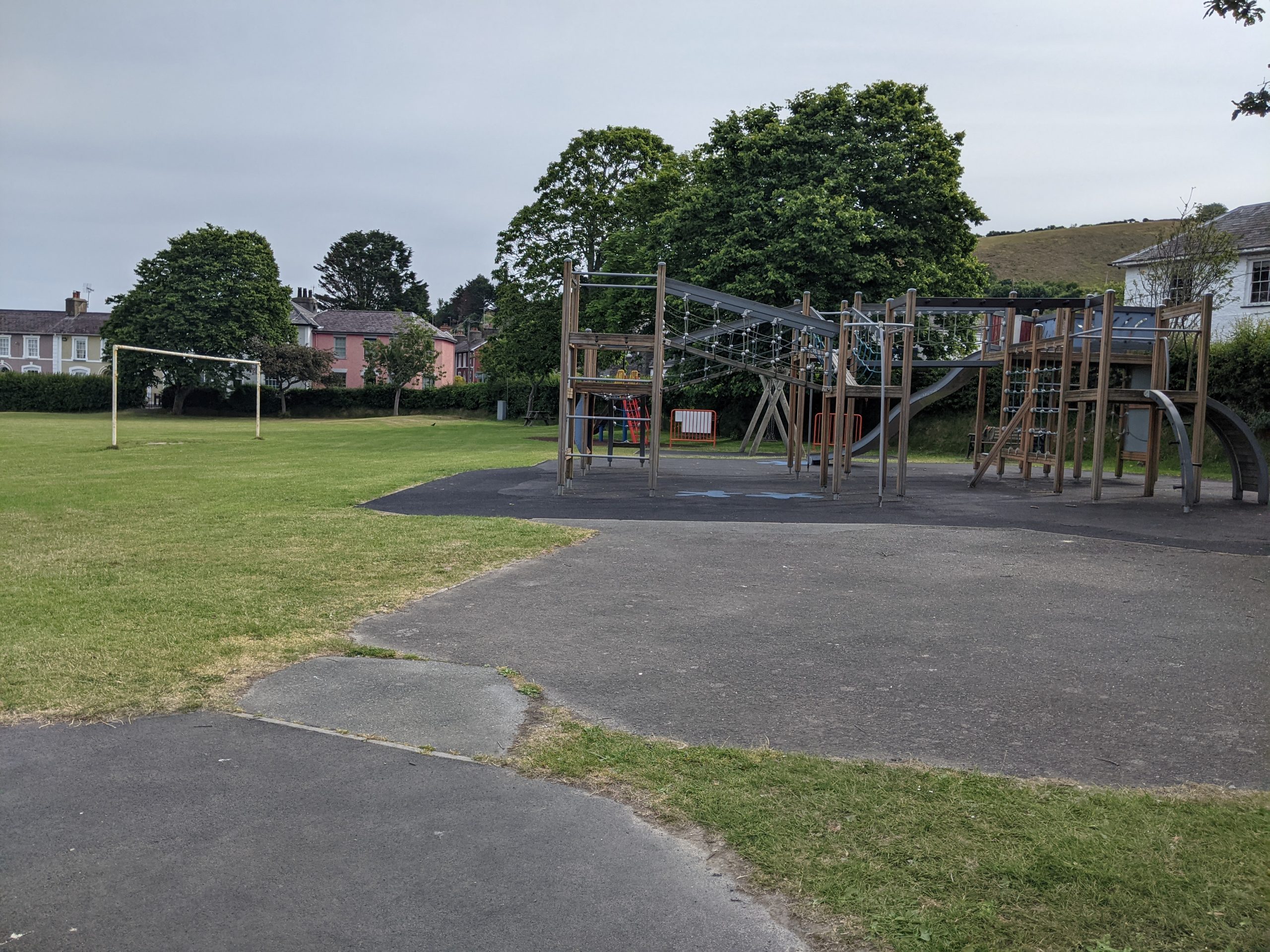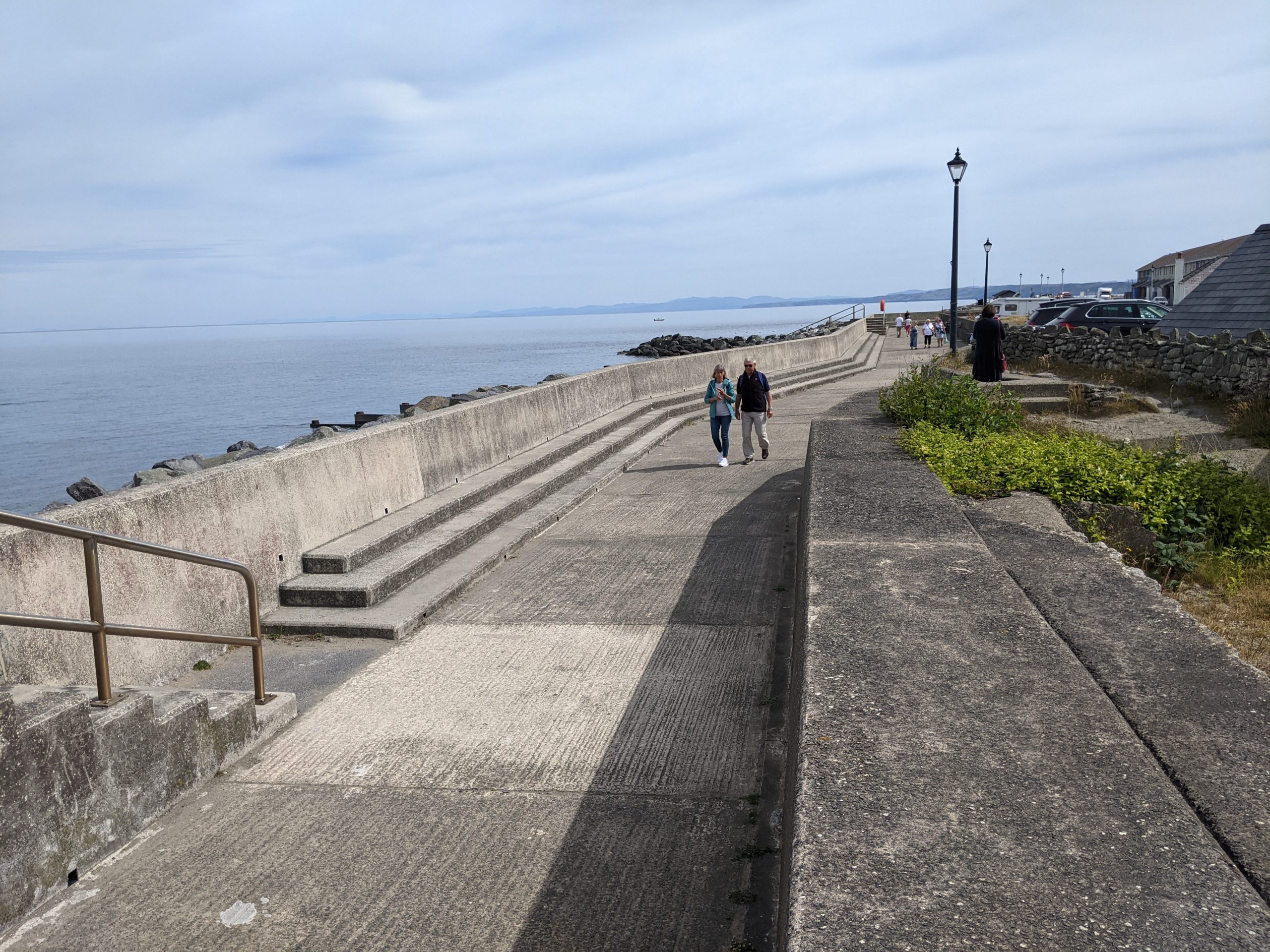Principle 3: Creating happy and healthy communities
How can GBI help to create happy and healthy communities?
Image: seafront walking opportunities in Ceredigion.

Access to green and blue spaces on your doorstep has long been known to benefit physical health. However, today it is increasingly linked to mental health– whether it’s a footpath for a morning dog walk, leafy trees on the local high street, or a local area to play. The experience of the Covid-19 pandemic from 2020 onwards only heightened awareness of these benefits.
For young people, opportunities to play outside, particularly in natural surroundings, are found to significantly reduce mental ill health.
Natural spaces are not only a forum for exercise. They can also provide the opportunities to come together and socialise. A ‘pocket park’ or bench within a residential area can provide space for casual interaction. Allotments and community gardens can connect people through volunteering.
GBI networks are increasingly recognised as part of preventative health care. ‘Green social prescribing’ is one innovative way being looked at by the NHS to prescribe nature-based interventions for a range of health concerns. It works by linking people with local ‘green’ activities, such as walking groups, community gardens and food-growing projects.
What does national and regional policy say?
The Well-being of Future Generations (Wales) Act 2015 was passed by the National Welsh Assembly in 2015. It focuses on how to improve quality of life for both current and future generations in Wales.
The Act put in place seven well-being goals. The goals are important building blocks for strategies like this and have been integrated into the themes which guide this Strategy.
‘Future Wales’ The National Plan 2040 sets the direction for future development in Wales. Policy 9 (Resilient Ecological Networks and Green Infrastructure) requires the use of nature‑based solutions within the GBI network as a key mechanism for social equality and well‑being.
The Environment (Wales) Act 2016 requires the production of Area Statements. Some of the key priorities in the Mid Wales Area Statement are helping people connect with their local environment to improve health and wellbeing, and developing opportunities to use nature as a tool in preventative medicine.
This is backed up by the ‘Prosperity for All’ economic action plan, which encourages an increase in physical activity in order to secure a healthy and active, united and connected Wales.
Planning Policy Wales (PPW), sets out the land use planning policies of the Welsh Government and highlights green infrastructure as an effective means of enhancing health and well-being by linking dwellings, workplaces and community facilities.
In their 2002 report ‘Developing standards for accessible natural greenspace in towns and cities‘, the Countryside Council for Wales (CCC) validated the Accessible Natural Green Space Standards (ANGS) for use in Wales. Ceredigion’s own policies reference the Fields in Trust standards.
In terms of play opportunities, the Children and Families (Wales) Measure 2010 places a duty on all Local Authorities across Wales to assess and secure sufficient play opportunities for children in their area. This is achieved through Play Sufficiency Assessments.
Another way of improving health outcomes through infrastructure is through the provision of green active travel routes. The Active Travel (Wales) Act encourages more people to undertake regular journeys on foot and bicycle. Finally, the Countryside and Rights of Way Act (2000) gives all the right of access on foot for the purpose of open-air recreation.
What does local policy say?
Policy LU22 (Community Provision) of Ceredigion’s existing Local Development Plan (LDP) seeks to sustain and enhance community provision by seeking to support the development of new sustainable community provision and by resisting the loss of existing community provision. This includes leisure and recreation facilities and open space.
In 2020, the Council assessed Ceredigion’s existing green infrastructure. The assessment identified the following objectives related to communities and health:
- To support and encourage all GI assets where possible, with particular consideration given to the enjoyment the sites provide to local communities.
- To increase the provision of new cycling and walking routes connecting settlements and to improve connectivity between towns and satellite villages.
Ceredigion’s 2019 Play Sufficiency Assessment forms part of the Welsh Government’s anti-poverty agenda, which recognises that children can experience poverty through lack of access to playful spaces. The assessment notes that play provision is in shorter supply in Ceredigion’s rural locations and that funding for such services has become increasingly tight. However, it notes that this could be addressed through improving accessibility to existing play spaces. It also highlights the important role of improved access to play assets through active travel infrastructure.
Ceredigion’s Corporate Strategy includes several principles relating to healthy communities. It sets out clear well-being objectives, including promoting and fostering healthy and active lifestyles within the community. A clear desired outcome of the strategy is to provide greater opportunities for residents of Ceredigion to embrace physically active and healthy lifestyles.
What are the challenges and pressures this GBI Strategy needs to address?
Image: Allotments in Aberaeron.

“Ceredigion is a beautiful county with some jewels in the crown in terms of nature reserves, if you know where to go… However, footpaths and ‘green corridors’ may not be very accessible or diverse in nature terms.”
– Stakeholder comment (survey)
ONS data shows that for 2016-18 in Mid Wales, healthy life expectancy for males and females were above the Welsh average in Ceredigion.
Ceredigion’s Wellbeing Assessment shows that the County has lower levels of childhood obesity (10.3%) compared to the national average of 12%. Just over 52% of school children aged 3 – 11 take part in at least three occasions of activity per week.
The assessment also found that levels of physical activity among adults also exceeds the national average.
However, the Welsh Index of Multiple Deprivation highlights spatial disparities in health between different parts of the County – with pockets of greater health deprivation (covering both physical and mental health) in particular. This is evident in urban areas of south Aberystwyth and south of Cardigan.
In terms of play provision, Ceredigion’s Wellbeing Assessment highlights that out of the 151 towns and villages in Ceredigion, 74 are equipped with play areas. This means that 77 of Ceredigion’s towns and villages do not have a play area – however many of these are likely to be small, rural hamlets.
Image: An existing play area in Aberaeron

Air quality in Ceredigion is relatively good compared to the rest of the country. In 2018, the level of nitrogen oxide (NO2) concentration was just 5 in Ceredigion, compared to 9 nationally. However, there are concentrations of poor air quality in certain areas – including denser areas such as Cardigan, Adpar and the south of Aberystwyth.
There is a notable urban- rural divide in Ceredigion. A geographical disconnect can be observed between Ceredigion’s urban dwellers and the County’s terrestrial designated sites, the majority of which are located in the north and east.
Health needs and challenges are likely to shift in line with Ceredigion’s changing demographics. The results of the 2021 census show that more than 1 in 4 people in Ceredigion was aged 65+. Between 2011-2021, there was an increase of around 17% in people in this age group, combined with a decrease of around 12% in those aged 15 – 64 years.
This trend is set to continue into the future.
Image: Coastal promenade in Aberaeron.

This means that the GBI network will need to evolve and adapt to meet the access needs of an older, less mobile population in the future.
With this in mind, stakeholders engaged during the development of this Strategy emphasised the need for walking and cycling routes to be accessible to all – including e-bikes for older demographics in particular – to promote active travel and a connection with nature – including improved links from outlying villages into towns. It was recognised that the rural nature of the area can make the creation of walking and cycling paths more challenging.
Maintenance issues with the public right of way (PROW) network were raised, with a need for improved signage and awareness of routes. The need to improve ‘ease of use’ was also highlighted in the Ceredigion Rights of Way Improvement Plan.
Image: Cycling opportunities in the landscape around Tregaron.

Summary of key issues
- Levels of health and wellbeing in Ceredigion are generally above national averages. However, there are pockets of poorer health, concentrated in particular in urban areas of Aberystwyth and Cardigan.
- Access to green space and GBI assets tends to be poorer further from the coast and in the north of the County. This raises the need for better access from more urban areas in the south of the County.
- Play provision is poor, with 77 towns and villages having no play area.
- Air quality challenges exist in denser parts of urban areas.
- Ceredigion’s GBI network will need to adapt to future changing demographics, notably a rapidly ageing population.
- There is room for significant improvement in walking and cycling routes and their maintenance – ensuring routes are accessible to all, to support policy targets for a shift away from the private car.